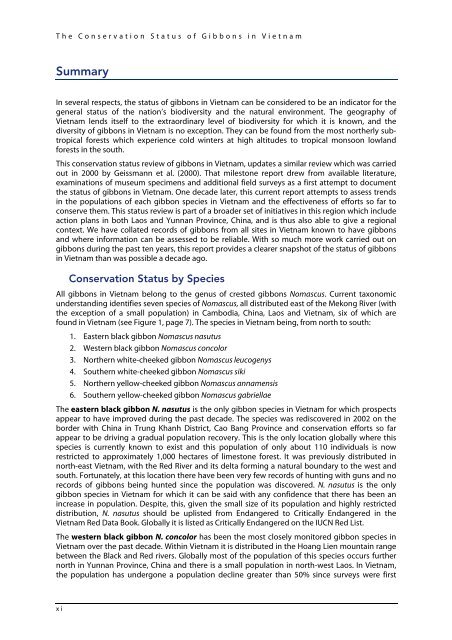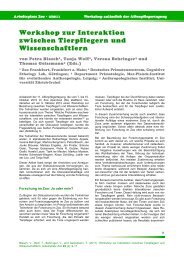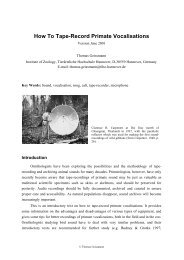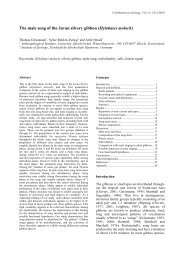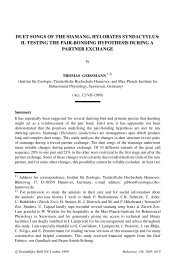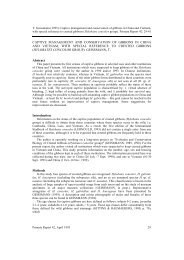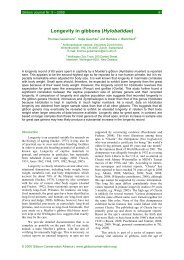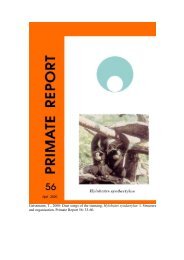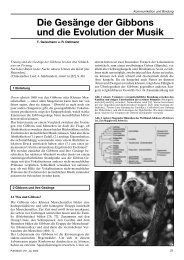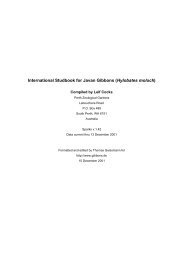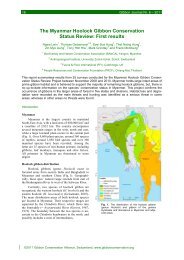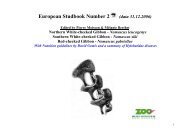The Conservation Status of Gibbons in Vietnam - Gibbon Research ...
The Conservation Status of Gibbons in Vietnam - Gibbon Research ...
The Conservation Status of Gibbons in Vietnam - Gibbon Research ...
Create successful ePaper yourself
Turn your PDF publications into a flip-book with our unique Google optimized e-Paper software.
<strong>The</strong> <strong>Conservation</strong> <strong>Status</strong> <strong>of</strong> <strong><strong>Gibbon</strong>s</strong> <strong>in</strong> <strong>Vietnam</strong>SummaryIn several respects, the status <strong>of</strong> gibbons <strong>in</strong> <strong>Vietnam</strong> can be considered to be an <strong>in</strong>dicator for thegeneral status <strong>of</strong> the nation’s biodiversity and the natural environment. <strong>The</strong> geography <strong>of</strong><strong>Vietnam</strong> lends itself to the extraord<strong>in</strong>ary level <strong>of</strong> biodiversity for which it is known, and thediversity <strong>of</strong> gibbons <strong>in</strong> <strong>Vietnam</strong> is no exception. <strong>The</strong>y can be found from the most northerly subtropicalforests which experience cold w<strong>in</strong>ters at high altitudes to tropical monsoon lowlandforests <strong>in</strong> the south.This conservation status review <strong>of</strong> gibbons <strong>in</strong> <strong>Vietnam</strong>, updates a similar review which was carriedout <strong>in</strong> 2000 by Geissmann et al. (2000). That milestone report drew from available literature,exam<strong>in</strong>ations <strong>of</strong> museum specimens and additional field surveys as a first attempt to documentthe status <strong>of</strong> gibbons <strong>in</strong> <strong>Vietnam</strong>. One decade later, this current report attempts to assess trends<strong>in</strong> the populations <strong>of</strong> each gibbon species <strong>in</strong> <strong>Vietnam</strong> and the effectiveness <strong>of</strong> efforts so far toconserve them. This status review is part <strong>of</strong> a broader set <strong>of</strong> <strong>in</strong>itiatives <strong>in</strong> this region which <strong>in</strong>cludeaction plans <strong>in</strong> both Laos and Yunnan Prov<strong>in</strong>ce, Ch<strong>in</strong>a, and is thus also able to give a regionalcontext. We have collated records <strong>of</strong> gibbons from all sites <strong>in</strong> <strong>Vietnam</strong> known to have gibbonsand where <strong>in</strong>formation can be assessed to be reliable. With so much more work carried out ongibbons dur<strong>in</strong>g the past ten years, this report provides a clearer snapshot <strong>of</strong> the status <strong>of</strong> gibbons<strong>in</strong> <strong>Vietnam</strong> than was possible a decade ago.<strong>Conservation</strong> <strong>Status</strong> by SpeciesAll gibbons <strong>in</strong> <strong>Vietnam</strong> belong to the genus <strong>of</strong> crested gibbons Nomascus. Current taxonomicunderstand<strong>in</strong>g identifies seven species <strong>of</strong> Nomascus, all distributed east <strong>of</strong> the Mekong River (withthe exception <strong>of</strong> a small population) <strong>in</strong> Cambodia, Ch<strong>in</strong>a, Laos and <strong>Vietnam</strong>, six <strong>of</strong> which arefound <strong>in</strong> <strong>Vietnam</strong> (see Figure 1, page 7). <strong>The</strong> species <strong>in</strong> <strong>Vietnam</strong> be<strong>in</strong>g, from north to south:1. Eastern black gibbon Nomascus nasutus2. Western black gibbon Nomascus concolor3. Northern white-cheeked gibbon Nomascus leucogenys4. Southern white-cheeked gibbon Nomascus siki5. Northern yellow-cheeked gibbon Nomascus annamensis6. Southern yellow-cheeked gibbon Nomascus gabriellae<strong>The</strong> eastern black gibbon N. nasutus is the only gibbon species <strong>in</strong> <strong>Vietnam</strong> for which prospectsappear to have improved dur<strong>in</strong>g the past decade. <strong>The</strong> species was rediscovered <strong>in</strong> 2002 on theborder with Ch<strong>in</strong>a <strong>in</strong> Trung Khanh District, Cao Bang Prov<strong>in</strong>ce and conservation efforts so farappear to be driv<strong>in</strong>g a gradual population recovery. This is the only location globally where thisspecies is currently known to exist and this population <strong>of</strong> only about 110 <strong>in</strong>dividuals is nowrestricted to approximately 1,000 hectares <strong>of</strong> limestone forest. It was previously distributed <strong>in</strong>north-east <strong>Vietnam</strong>, with the Red River and its delta form<strong>in</strong>g a natural boundary to the west andsouth. Fortunately, at this location there have been very few records <strong>of</strong> hunt<strong>in</strong>g with guns and norecords <strong>of</strong> gibbons be<strong>in</strong>g hunted s<strong>in</strong>ce the population was discovered. N. nasutus is the onlygibbon species <strong>in</strong> <strong>Vietnam</strong> for which it can be said with any confidence that there has been an<strong>in</strong>crease <strong>in</strong> population. Despite, this, given the small size <strong>of</strong> its population and highly restricteddistribution, N. nasutus should be uplisted from Endangered to Critically Endangered <strong>in</strong> the<strong>Vietnam</strong> Red Data Book. Globally it is listed as Critically Endangered on the IUCN Red List.<strong>The</strong> western black gibbon N. concolor has been the most closely monitored gibbon species <strong>in</strong><strong>Vietnam</strong> over the past decade. With<strong>in</strong> <strong>Vietnam</strong> it is distributed <strong>in</strong> the Hoang Lien mounta<strong>in</strong> rangebetween the Black and Red rivers. Globally most <strong>of</strong> the population <strong>of</strong> this species occurs furthernorth <strong>in</strong> Yunnan Prov<strong>in</strong>ce, Ch<strong>in</strong>a and there is a small population <strong>in</strong> north-west Laos. In <strong>Vietnam</strong>,the population has undergone a population decl<strong>in</strong>e greater than 50% s<strong>in</strong>ce surveys were firstxi


